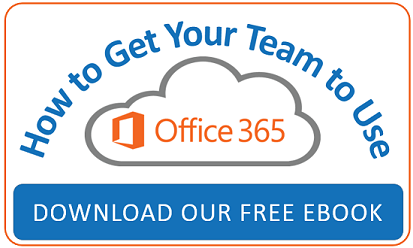 You deployed Office 365 and now you're faced with how to increase workplace productivity and efficiency. I understand the challenges.
You deployed Office 365 and now you're faced with how to increase workplace productivity and efficiency. I understand the challenges.
Many clients I work with deploy Office 365 in stages. While they see increased efficiency with each part of Office 365 deployed, they face adoption and acceptance challenges around every corner. Their biggest challenges for increasing workplace efficiency come after the early wins.
Using Office 365 for email is an easy win
It's typical for our clients to deploy Office 365 as a cloud solution for email. Boom, that's it for their first step. That deployment alone brings great benefits like cost savings, increased efficiency and ease-of-access to email for users across various devices.
Next stop: Office 2016
Next up is usually an upgrade to Office 2016 on the desktop for some users, coupled with a future plan for "simple" E1 or G1 licenses for users that just crack the surface of desktop application functionality. Deployment of the Office Online applications sparks the conversation about OneDrive and SharePoint Online. Those online Office apps will require that documents and spreadsheets live in the cloud.
Next up, and often an ROI justifier, Skype for Business. It can provide businesses with cost savings by eliminating the need and associated costs of other software like WebEx or GoToMeeting. Streamlined communication and utilization of Instant Messaging (IM) that's integrated throughout the Office Suite can decrease email clutter and reduce the need for formal meetings that block employee's schedules and potentially limit a user's availability for other customer-centric work.
When does true measurable workplace efficiency begin?
While the deployment of anywhere email, using the Outlook client, Outlook on the Web and the newest addition, the Outlook App for Android and iOS, provides an always available experience for the user, and that's good for business, true workplace efficiency expands with user utilization of all of Office 365's capabilities.
Often times, deployment to the new version of Office is seen by the end-user and their managers as an upgrade and that's it. Managers and users aren't knowledgeable about the potential for increased productivity because they continue to use the newest version of Office the way they always have. You know what? That's not their fault. Many users of Office applications don't know what they don't know.
Whose role is it?
As an IT leader, it may not be in your job description, but sometimes it's an unwritten responsibility to help build awareness. The good news is you don't have to do it alone, but you'll need to recruit some help.
This past August I wrote about why you need an Office 365 champion. What I didn't really cover in that post was how to build your army of champions. A key component for successful user adoption is creating a tipping point.
I noted in that post, "Equipped with extra know-how, champions help transform the organization from within. They lead by example and help their peers use the technology more effectively." A great first step to winning your managers over is to understand their challenges.
So how do you get your champions onboard?
As an IT professional, you get it, you live and breathe technology and you're probably an early adopter. Being on the inside you understand and hopefully feel sympathetic to the challenges managers and users in your company experience.
Identifying from your mountaintop view a solution that can leverage Office 365 to improve a workflow or process for a manager is often the first tipping point for acceptance. Getting a manager's buy-in helps to build the awareness for Office 365 solutions and most importantly it helps them bring acceptance to that change to the end user.
Maybe it's terabytes of data that seem impossible for various reasons to move to the cloud, or perhaps it's a senior partner that's saying no to SharePoint and or OneDrive for fear of document leakage. Whatever the challenge, think small at first.
A massive trove of documents, that likely includes many that you don't even need, can be a big hill to climb. Instead look at a small block of content that can be effectively managed for a group in your organization. Think of it as an expedition to mount Everest. Each block of content that is moved, is a path towards the summit. When that content is established in the cloud make sure managers understand key benefits like: check in-check out, versioning options and search.
Simple...but impressive
Show them Document or Library alerts. While simple, these are eye-opening WOW functions for many managers that are used to accessing files on a local network. Manager buy-in starts to open additional paths to the mountain top because now you're showing automation and workflow in a very small user-driven manner.
And for that VP who's concerned about document leakage or security, start to show them how that small batch of content being accessed in the cloud, is being better managed and is more secure than ever. Our friends at ShareGate have a great post: SharePoint Online Security: as Good as Your Bank's? Just like the managers, the fear in the C-suite isn't their fault. They probably have little or no knowledge about eDiscovery and what the Office 365 Security and Compliance Center can do to protect your businesses data.
You don't reach the summit overnight.
Workplace efficiency and change come over time. It takes lots of planning and a really good Sherpa. That's you.








